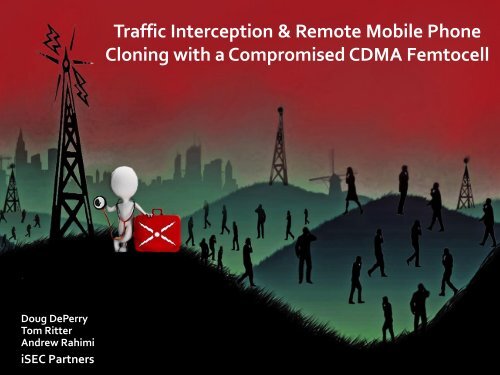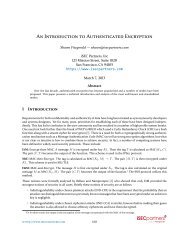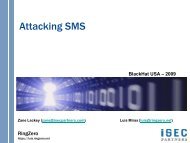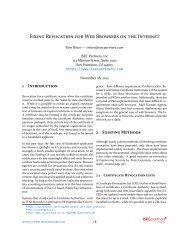Here - iSEC Partners
Here - iSEC Partners
Here - iSEC Partners
You also want an ePaper? Increase the reach of your titles
YUMPU automatically turns print PDFs into web optimized ePapers that Google loves.
Doug DePerry<br />
Tom Ritter<br />
Andrew Rahimi<br />
<strong>iSEC</strong> <strong>Partners</strong><br />
Traffic Interception & Remote Mobile Phone<br />
Cloning with a Compromised CDMA Femtocell
• The specific method used to access the device that<br />
makes the demonstration possible has been resolved by<br />
Verizon Wireless through a security patch.<br />
• The Network Extenders being used to conduct the<br />
demonstration do not have the security patch installed.<br />
• Verizon Wireless gave <strong>iSEC</strong> permission to use the<br />
network extenders to conduct the demonstration in<br />
consideration of <strong>iSEC</strong> bringing the issue to the attention<br />
of Verizon Wireless.<br />
2
No User Interaction<br />
• This is not like joining an open WiFi network<br />
• Your phone associates automatically with no*<br />
indication<br />
• You might be on ours right now. <br />
• We don’t hack phones… at least not today<br />
3
Full Disclosure<br />
• Disclosed vulnerabilities to the carrier early December<br />
• They worked extremely hard, over Christmas, to prepare<br />
a patch<br />
• All vulnerabilities disclosed in this presentation have<br />
been patched<br />
• We do have architectural concerns around femtocells<br />
• Concerns shared by…<br />
4
Prior Art<br />
• BH 2011 “Femtocells: a Poisonous Needle in the<br />
Operator's Hay Stack”<br />
• SFR Femtocell (2nd biggest operator in France)<br />
• THC: Vodafone (2010/2011)<br />
• RSAXVC & Doug Kelly (Bsides KC 2011)<br />
• Rooting<br />
• Cable construction<br />
• “Do It Yourself Cellular IDS”<br />
• Black Hat 2013<br />
5
Our Focus<br />
• North American Carrier<br />
• 3G<br />
• CDMA<br />
• Customers affected<br />
• Roughly 1/3 of the population of the US<br />
• Phone Calls & SMS<br />
• MMS, Data Man-In-The-Middling, SSL Stripping<br />
• Cloning<br />
6
Agenda<br />
Rooting<br />
Exploring<br />
• Filesystem<br />
• Traffic<br />
Exploiting<br />
• Voice, SMS, Data<br />
Cloning<br />
Fixing<br />
7
General Architecture<br />
We Are <strong>Here</strong>! <br />
8
Rooting the Femtocell(s)<br />
SCS-26UC4<br />
(Older)<br />
SCS-2U01<br />
(Newer)<br />
9
Rooting the Femtocell(s)<br />
SCS-26UC4<br />
(Older)<br />
Bonus!<br />
SCS-2U01<br />
(Newer)<br />
10
SCS-2U01 Hardware<br />
• Faraday FA626TE ARM v5TE processor<br />
• on Samsung UCMB board<br />
• OneNAND flash memory<br />
• Lattice FPGA<br />
• Presumably for DSP<br />
• GPS antenna<br />
• CDMA antenna<br />
• 2G/3G<br />
• Ethernet<br />
• HDMI Port<br />
11
Console Port<br />
• HDMI port<br />
12
Custom Cable<br />
• USB FTDI + HDMI =<br />
13
Wireless Signal Range<br />
• Approximately 40’<br />
• Environmental factors<br />
• Adjust signal strength<br />
• Amplify<br />
14
Console Access!<br />
• SCS-26UC4<br />
• 57600 8 N 1<br />
• Uboot delay: “Press any key to interrupt boot”<br />
• Root shell<br />
• Run /etc/init.d/rc 5<br />
• Root on fully functional device<br />
• SCS-2U01<br />
• 115200 8 N 1<br />
• Magic sysreq + i<br />
• Root login<br />
• Run /etc/init.d/rc 5<br />
• Root on fully functional device<br />
15
Console Access: Patched<br />
These mechanisms to obtain root no longer work<br />
(But may be useful on other embedded devices)<br />
16
Exploring the Femtocell<br />
17
Filesystem<br />
• MontaVista Linux 5, 2.6.18<br />
• Custom kernel, drivers, software<br />
• /mnt/onand<br />
• Custom application binaries<br />
• uimhx, cmbx, cdhx, agent, vpn<br />
• Keys, passwords, etc<br />
• /etc/shadow<br />
• /app/vpn/quicksec.xml<br />
18
I am root, but…<br />
• This terminal console sucks<br />
• Can’t really do anything<br />
• Let’s patch<br />
• No easy way to edit files<br />
• ugh, sed<br />
• SSHD<br />
• PKI-only, no RootLogin<br />
• Edit SSHD.conf<br />
• Flush iptables<br />
19
Be Persistent<br />
• Filesystem is pulled from firmware every single time<br />
• Any changes disappear on reboot<br />
• Have to edit firmware and reflash?<br />
• Until we noticed…<br />
• Persistent filesystem location<br />
• /mnt/onand<br />
20
Be Persistent<br />
• Read every single startup script until…<br />
if [ -f /mnt/onand/.ubirc ]; then<br />
echo 'DEBUG MODE STARTUP is TARTTING....’<br />
. /mnt/onand/.ubirc<br />
That’s the part of the<br />
filesystem we can persist in!<br />
21
Be Persistent<br />
• .ubirc<br />
• Presence of this file == debug mode<br />
• We use it to run scripts<br />
• Patch sshd<br />
• Allow interactive root login<br />
• Flush iptables<br />
• exec /bin/bash<br />
22
Let’s go after the data<br />
• We’re persistent<br />
• Call me Eve<br />
• Let’s go find the packets!<br />
• QuickSec VPN client<br />
• Packaged as a Netfilter kernel module<br />
• Literally steals packets out of Netfilters and handles them itself…<br />
• Packets don’t show up in normal capture tools like tcpdump<br />
• Not Open Source<br />
23
It’s Just Engineering<br />
24
I want packets!<br />
• Custom kernel module<br />
• Priority is tricky<br />
• Incoming/Outgoing<br />
• Must be above & below quicksec to get the plaintext before<br />
encryption and after decryption<br />
• Custom Userland app<br />
• Display data in real-time<br />
• Log to pcap<br />
• Cross-compiling is fun*<br />
• *fun like a hernia<br />
25
Voice, Texts, and Data<br />
26
Voice: Lots ‘o packets<br />
• Its mostly UDP, lots and lots of UDP<br />
• Strange Ports<br />
• This is hard.<br />
27
Voice: Force Decode as RTP<br />
28
Voice – Codec?<br />
RFC 3558:<br />
Value Rate Total data frame size<br />
---------------------------------------------------------<br />
0 Blank 0 (0 bit)<br />
1 1/8 2 (16 bits)<br />
2 1/4 5 (40 bits; not valid for EVRC)<br />
3 1/2 10 (80 bits)<br />
4 1 22 (171 bits; 5 padded at end w/ zeros)<br />
5 Erasure 0 (SHOULD NOT be transmitted by sender)<br />
29
Voice – Codec?<br />
No Answers!<br />
30
Voice – Codec?<br />
31
Voice!<br />
http://www.youtube.com/watch?v=3FyNB4QmY1Q<br />
32
SMS<br />
• These specs suck<br />
• But we figured it out<br />
• 7-bit Words, ugh<br />
33
SMS<br />
34
SMS<br />
http://www.youtube.com/watch?v=R-4fkJiVeE4<br />
35
Data<br />
• Plaintext! Praise the Lord: beautiful, decoded, plaintext<br />
• Easiest thing to do with data: View It.<br />
36
MMS<br />
http://www.youtube.com/watch?v=uuwsMsvGAYo<br />
37
Data<br />
• Plaintext! Praise the Lord: beautiful, decoded, plaintext<br />
• Easiest thing to do with data: View It.<br />
• Second easiest thing to do with data: Drop It.<br />
38
iMessage<br />
• And when you Denial of Service some data services, they<br />
fail over insecurely…<br />
39
Data<br />
• Back to the Data. It is plaintext.<br />
• However: Lots of encapsulation<br />
• If we’re lucky: IP, GRE, PPP, HDLC, IP…<br />
• If we’re not: IP, GRE, PPP, HDLC & then IP segmented<br />
across GRE packets<br />
40
Data Traffic<br />
41
Data Middling<br />
• Goal: Edit a Webpage, as simply as possible<br />
• (Change HTTPS Form Action - > HTTP)<br />
• Going to require editing the inner TCP checksum<br />
• Which requires decoding and re-encoding<br />
• And editing the PPP checksum<br />
• And hopefully doesn’t change the size<br />
• TCP Checksum is at the beginning (GRE frame N)<br />
• PPP Checksum is at the end (GRE frame N+3? 4?)<br />
• Oh, and the frames may be out of order<br />
42
Data Middling<br />
• Try 1:<br />
• Do it inline, in the kernel<br />
• Nope: Carrier applies transparent compression to all<br />
traffic on port 80<br />
• Can’t collect packets to decompress, edit, and<br />
recompress, can’t only edit one packet at a time<br />
• Try 2:<br />
• Change the request to HTTP 1.0 (No Compression)<br />
• Nope: Carrier Ignores it<br />
43
Data Middling<br />
• Try 3:<br />
• DNS Hijack, send everyone to our server<br />
• Nope: Carrier does transparent proxying on port 80, then<br />
does own lookup based on Host header<br />
• Try 4:<br />
• DNS Hijack AND rewrite all connections to port 80 on our<br />
IP to port 81, and back again<br />
• Nope: Corner Cases. If they happen 2% of the time, on a<br />
normal webpage, it’s dozens of packets.<br />
44
Data Middling<br />
• Try 5:<br />
• DNS Hijack, rewrite all connections to port 80 on our IP to<br />
port 81, and back again, AND Redirect people to 8080<br />
• Success!<br />
• The corner cases don’t occur on the small 301 redirect<br />
• We can proxy the real webpage to users, ferrying their<br />
cookies and form posts, and:<br />
• Strip SSL<br />
• Rewrite URLs to port 8080<br />
45
Data Middling Video<br />
http://www.youtube.com/watch?v=2xjhtDobO8c<br />
46
Miniature Cell Towers<br />
• Eavesdropping is cool and<br />
everything but…<br />
• Impersonation is even cooler.<br />
47
Cloning<br />
48
CDMA Terminology<br />
• No SIM Cards needed here<br />
GSM<br />
CDMA<br />
Device ID IMEI ESN (Now MEID)<br />
Subscriber ID IMSI MIN<br />
User Phone # MSISDN MDN<br />
• Unlike the IMSI, the MIN is just a 10 digit phone number,<br />
sometimes the same as your actual phone number<br />
49
CDMA Terminology<br />
• ESN (Electronic Serial Number)<br />
• CDMA-specific ID number: “11 EE 4B 55”<br />
• MEID (Mobile Equipment Identifier)<br />
• ESNs ran out! MEID is successor<br />
• Pseudo ESN used for backwards compatibility with<br />
handsets using MEIDs: “80 11 EE 4B”<br />
• (Phones often ALSO have an IMEI for global or 4G)<br />
50
Cloning basics – Real Towers<br />
• Every time you make a call, MIN and MEID or ESN sent<br />
unencrypted to the tower to identify you<br />
• That used to be it, and cloning was rampant<br />
MIN, MEID/ESN<br />
51
Enter the CAVE<br />
• CAVE (Cellular Authentication and Voice Encryption)<br />
• Every phone has a secret A-Key, which generates two<br />
derivative keys used to authenticate every call and message,<br />
as well as encrypt voice traffic over the air<br />
• The A-Key is never shared over the network, but the<br />
derivative keys are used for every call<br />
52
Connecting to a Femtocell<br />
• The femtocell acts just like any other tower, except it<br />
doesn’t actually require the MEID<br />
• ESN is used with older devices, and pESN is used instead<br />
of MEID on newer devices<br />
(p)ESN, MIN<br />
53
Remember Your Failure At The CAVE…<br />
• The femtocell does not use MEIDs for authentication at all,<br />
only the (p)ESN and MIN<br />
• And most importantly, the femtocell didn’t require CAVE!<br />
• This means that a “classic” clone with just the (p)ESN and<br />
MIN would work - as long as the attacker’s clone is connected<br />
to a femtocell<br />
• We just need the (p)ESN and MIN of our victim<br />
(p)ESN, MIN<br />
54
The Perfect Clone<br />
• (p)ESN/MIN values are passed through the femtocell in a<br />
registration packet whenever ANY phone comes within<br />
range<br />
• This allows cloning without physical access to phone<br />
55
The Perfect Clone<br />
0x80123456<br />
(201) 555 - 1234<br />
Step 1: Victim phone falls in range of<br />
rooted femtocell with sniffer<br />
Step 2: MIN and ESN are collected and<br />
cloned to a target device<br />
Step 3: Target device is associated with<br />
a stock femtocell<br />
Step 4: Clone attained; calls and SMS<br />
can be made on behalf of original phone<br />
56
Cloning Implications<br />
• Cloning can be flakey<br />
• Voice<br />
• The elusive 2.5-way call<br />
• SMS<br />
• Data<br />
• Not yet….<br />
• Helpful definitions for our discussion:<br />
• Victim phone – the phone of a legitimate subscriber<br />
whose keys have been captured by a rogue femtocell<br />
• Target phone – the phone of an attacker that has been<br />
modified (cloned) to the legitimate victim phone<br />
57
Cloning Scenario 0<br />
When the VICTIM phone is turned off or jammed<br />
• Everything works<br />
• Incoming Call<br />
• Outgoing Call<br />
• SMS<br />
58
Cloning Scenario 1<br />
When both the TARGET and VICTIM phones are<br />
associated with the femtocell.<br />
• Outgoing Call<br />
• Forced drop<br />
• SMS<br />
• Incoming<br />
59
Cloning Scenario 1<br />
When both the TARGET and VICTIM phones are<br />
associated with the femtocell.<br />
Carrier<br />
• Incoming Call<br />
• Only one phone rings<br />
• Situation normal<br />
• Both phones ring<br />
• The race is on<br />
• “Two-and-a-half”-way call<br />
Third Party Caller’s Voice<br />
Target’s Voice<br />
Victim’s Voice<br />
Passive Association<br />
60
Cloning Scenario 2<br />
When only the TARGET phone is associated to the femtocell and<br />
the VICTIM phone is on an actual Verizon tower<br />
Carrier<br />
• Incoming Call and SMS<br />
• Most recent carrier contact<br />
• Outgoing Call<br />
• TARGET call is dropped<br />
• Two for one!<br />
61
Cloning Data<br />
• Much more difficult<br />
• Need more keys<br />
• Valid NAI<br />
• HA<br />
• AAA<br />
62
Cloning Video<br />
http://www.youtube.com/watch?v=Ydo19YOzpzU<br />
63
Cloning: Patched<br />
The requirement for CAVE Authentication to be enabled<br />
takes place on the Carrier Network (not the femtocell).<br />
Accordingly, it was patched without requiring any<br />
software updates to the femtocell.<br />
64
Femtocells are a Bad Idea<br />
65
Major US Carrier Comparison<br />
Carrier Technology Femtocell?<br />
Verizon CDMA Yes<br />
Sprint CDMA Yes<br />
AT&T GSM Yes<br />
T-Mobile GSM No<br />
66
Short Term Mitigations<br />
• Harden the femtocell hardware and software<br />
• That might help except…<br />
67
Root is always possible<br />
“If an attacker has physical control over your computer…<br />
it’s not your computer anymore.”<br />
68
Root is always possible<br />
• We got in through a serial port<br />
• JTAG / UART ports?<br />
• Reflash firmware?<br />
• Glitching Attacks?<br />
69
Short Term Mitigations<br />
Require phone registration<br />
• Capability currently<br />
exists<br />
70
Femtocell Handset Registration<br />
Vendor Tech Femtocell Requires Registration<br />
Verizon CDMA Yes<br />
Sprint CDMA Yes<br />
AT&T GSM Yes<br />
No<br />
Optional per Femtocell<br />
No<br />
Optional per Femtocell<br />
Yes!<br />
T-Mobile<br />
GSM<br />
No!<br />
Wi-Fi Calling<br />
N/A<br />
71
Short Term Mitigations<br />
Require phone registration<br />
• Capability currently<br />
exists<br />
• Protects against<br />
untargeted dragnets<br />
• Does not protect against<br />
isolation attacks<br />
72
Long Term Mitigations<br />
• Get rid of ‘em<br />
• WiFi Calling<br />
• IPSec or SSL Tunnel<br />
• End-to-End encryption<br />
• OSTel & CSipSimple/Groundwire<br />
• RedPhone<br />
• ZRTP<br />
73
Fixes & Bandaids<br />
74
Mitigation Summary<br />
• Short Term<br />
• Harden femtocell<br />
• Require registration<br />
• Long Term<br />
• No femtocells<br />
• Move to WiFi Calling<br />
• End-to-end Encryption<br />
75
What Can I Do?<br />
• How do I know if I’m connected to a femtocell?<br />
• Android - some phones display an icon when connected<br />
to a femtocell<br />
• Phones that Verizon modified<br />
• Not Stock Android, Not Third Party ROMs<br />
• iPhone – No visual indicator<br />
• All - Short beep at beginning of phone call (easy to miss)<br />
• But somewhere, there’s code written to detect them<br />
76
Announcing FemtoCatcher<br />
• Detects femtocells and<br />
puts you in airplane<br />
mode<br />
• http://github.com/isecp<br />
artners/femtocatcher<br />
• Thanks immensely to<br />
Mira Thambireddy<br />
77
What Else Can I Do?<br />
• End-To-End Encryption<br />
• Voice<br />
• RedPhone<br />
• OSTel<br />
• SMS / Chat<br />
• TextSecure<br />
• Gibberbot<br />
• Silent Circle<br />
• Wickr<br />
• Browsing<br />
• VPN<br />
• Tor (Android: Orbot+Orweb<br />
iOS:Onion Browser)<br />
78
Future Work<br />
79
WAP (Wireless Application Protocol)<br />
• Custom Protocols<br />
• Heavily Proxied<br />
• Forced gzip<br />
• Chunked Encoding<br />
• SSL Middling<br />
• Advertised…<br />
• …or not (Nokia)<br />
80
WAP<br />
81
Fuzzaaaaaaaaaaaaaaaaaing<br />
• What happens when you fuzz the baseband?<br />
82
Internal Femtocell Network<br />
• Femtocell -> Femtocell (rsaxvc/BH2011)<br />
• Femtocell -> Internal Carrier Network (BH2011)<br />
83
Thank You & Questions?<br />
• Doug DePerry<br />
• Senior Security Engineer at <strong>iSEC</strong> <strong>Partners</strong><br />
• @dugdep<br />
• doug@isecpartners.com<br />
• Tom Ritter<br />
• Principal Security Engineer at <strong>iSEC</strong> <strong>Partners</strong><br />
• @TomRittervg<br />
• tritter@isecpartners.com<br />
• Thanks to<br />
• RSAXVC & Doug Kelly<br />
• Andrew Rahimi, Davis Gallinghouse, Tim Newsham<br />
• These guys did much of the hard work<br />
• Mira, Michael, Pratik, Peter Oehlert, Joel Wallenstrom, and really all of <strong>iSEC</strong><br />
84







